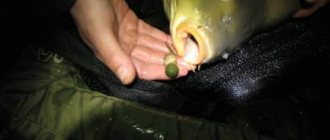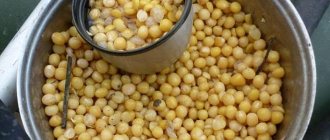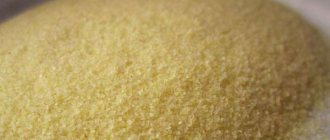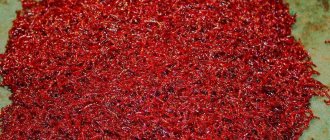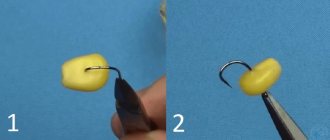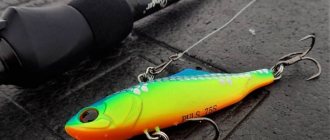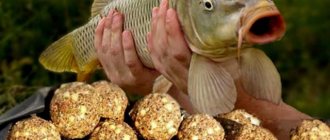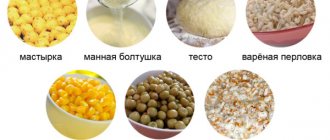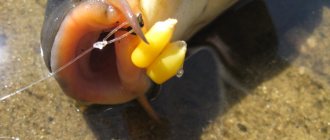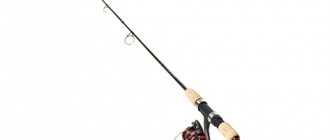One of the most common types of bait and groundbait that is popular among anglers is corn.
This is due to the fact that this cereal is a cheap and affordable product that can be purchased in almost any grocery store. Thanks to its bright color, smell, as well as specific taste characteristics, it actively attracts the attention of fish. There are several types of corn, as well as recipes and methods of preparing it, which allow you to use this cereal both as bait and as bait.
Carp on corn is sometimes no worse than on boilies
Using corn as bait and bait
A grain such as corn has been used for a long time by many fishing enthusiasts as the main ingredient in the preparation of bait, as well as in the form of bait or bait. Compared to other baits and baits, corn grains have a high level of catchability in any season.
However, before you use corn as bait or groundbait when fishing, you need to choose it wisely, as well as properly prepare it and place it on the hook.
Interesting fact! According to experienced fishermen, when using this cereal, the catch rates of fish such as crucian carp increase approximately 2 times.
What kind of fish can you catch with hominy?
So, it can be used to catch fish such as crucian carp, carp, bream, roach, silver bream and other similar fish. They are found quite often in ordinary fresh waters.
During cooking, it is necessary to take into account the fact that the fish smells very well, and if the hominy is prepared in violation of the recipe, then all the fish can be scared away.
For each fish, a certain fishing procedure is often followed, since they differ in size and, accordingly, this can affect the size of the bait. Some sense hominy very quickly, while others need additional means that can affect the quick reaction of the fish.
These criteria should be considered during the fishing process and fish selection. Experienced fishermen are well versed with the proportions of hominy. You can also find out more in specialized literature or on fishing websites.
What kind of fish bites on corn - who loves tasty grains?
Corn is very popular among fishermen due to its low cost, availability, and high catchability. It actively attracts fish due to its pleasant taste, aroma, and bright color, which has an irritating effect on underwater inhabitants.
In addition, this cereal can be successfully combined with a variety of flavors that will increase its catchability.
Thanks to the use of such bait, you can quite successfully catch almost all “white” fish. However, some representatives of freshwater bodies are distinguished by their greatest love for corn. Representatives from the carp family bite best on it; in particular, the following types of fish like corn:
- carp and carp;
- asp;
- chub;
- silver carp;
- verkhovka;
- gudgeon;
- crucian carp;
- tench;
- rudd
In addition, such plant bait can attract other fish that do not belong to the class of predators. Often red crucian carp, carp or carp actively bite on it. However, the biggest fan of this bait is carp. This fish will never swim past a grain of corn.
It is for this reason that corn grains are often used during carp fishing as bait or as a feeding dish. It is worth noting that most sport fishing enthusiasts, when fishing for carp, give their preference to this particular bait, prepared in several different versions.
The best corn for fishing for carp and other carp fish:
Spring porridge recipes for various types of fish
Porridge for crucian carp
Crucian carp is a fish that can be found in almost any body of water. There is even such a category of fishermen as “crucian fishermen”. Crucian carp, like all cyprinids, may prefer corn porridge. It is prepared as follows:
- Take a pan and pour water into it and add corn grains, adding a teaspoon of sugar.
- The corn is cooked for at least 2 hours, with occasional stirring.
- Once ready, let it cool to room temperature. It is then passed through a meat grinder and mixed with animal feed.
- To make the porridge have an attractive aroma, you can add drops of anise, vanillin or chopped garlic to it.
Porridge for carp
A feeder like a spring is also used for carp fishing. Catch porridge can be prepared according to this recipe:
- 800 grams of peas are poured into a saucepan with water and cooked until smooth.
- While the porridge is cooling, take a bag of fried seeds and pass it through a meat grinder.
- 400 grams of semolina are gradually added to the cooled porridge with constant stirring.
- The porridge is stirred until it acquires the consistency of hard dough. After this, the crushed seeds are poured here.
- Finally, the whole mass is thoroughly mixed again.
The resulting porridge can be divided into several parts and placed in plastic bags. The porridge is stored for no more than 24 hours, after which it loses its attractive properties. In this regard, such porridge should not be prepared for long-term storage. It is suitable for one-time use.
What types of corn are used during fishing?
This cereal, used as fishing bait, can be roughly divided into several different types. The most common types of corn used during fishing are:
- Fermented drunken corn.
- Artificial corn.
- Sweet.
- Steamed.
- Canned.
Preparing Fermented Corn for Fishing:
In addition, this bait is often used raw or subjected to a so-called fermentation process. If necessary, to prepare corn grains, depending on the recipe, you can use a slow cooker, steaming in a thermos, or cooking on an ordinary gas stove.
Are flavorings needed?
As discussed earlier in this article, scents play a very important role in attracting fish. The importance of hominy is to get the fish to taste the mush and swallow the hook. Fragrances, in turn, should attract prey with their scent. These additives can be vanilla, honey, cinnamon and other possible options.
Flavorings enhance the smell several times , which has a very positive effect on the catch, so it is worth using them as much as possible when preparing hominy for fishing.
Depending on the type of fish, various seasonings are used to help attract what you need. You can also add various dyes to hominy, which can also affect the attraction of fish.
When fishing, do not use float tackle
Most often, grains are used as bait when fishing with a float rod. In this case, it is necessary to choose equipment (especially when fishing for representatives of the carp family) with a rod length from 3.6 to 4.5 meters.
And for catching large carp, a short rod is not suitable at all, since it will not allow you to successfully catch large, strong fish.
The fishing line for the fishing rod should be thin, but at the same time strong. It must withstand a load of up to 12 kg.
This is due to the fact that most representatives of the carp family are extremely cautious and simply ignore baited hooks equipped with thick, catchy fishing line.
When fishing on a float, you can plant grains simply by threading them through the sting without “smart” installations
On a note! When using corn grains, it is recommended to use hooks No. 2-6, with a short shank. It is better to choose a float, especially when fishing for carp, that is small and inconspicuous.
Selection of canned corn for fishing
Canned corn is very popular, especially among carp anglers. Unlike regular, unprocessed grain, it has a number of advantages:
- has a sharp, attractive aroma;
- has a specific shade;
- holds well on the hook, even during long casts;
- does not require preliminary preparation (ready-made canned corn can be purchased on the way to the reservoir).
However, not all canned grains are suitable for fishing. When choosing such a nozzle, you need to pay attention to the date of its manufacture, the quality and shape of the grains. It is preferable to select cereals with a rounded shape, in which there are no voids. In addition, the best canned corn kernels should be firm and have a rich, vibrant flavor.
In specialized fishing stores you can purchase ready-made canned corn, which differs in taste, shape and size.
For carp fishing, it is preferable to use sweet canned grains. They go well with animal baits such as maggots, bloodworms or worms. The juice from canned grains can be used to make bait.
Important! It is recommended to use canned corn all at once, during one fishing trip. This is due to the fact that an open jar of grains will not be stored for a long time. However, if necessary, in order to preserve the properties of this bait, it can be placed in an airtight container, into which you need to add a small amount of vegetable oil.
Canned corn - the easiest way to cook
Bait preparation methods
You can purchase corn bait at any specialized store that sells fishing accessories and tackle.
But it’s best to make it yourself at home - this will save money and time. The main ingredient of this composition is corn kernels, which are sold in any grocery store.
Of course, if you use corn from a can, you should understand that the small size of the grains will attract the attention of small fish. In addition, you may come across crushed or cut segments of grains
They are very difficult to attach to the hook and large fish will easily knock down such bait. Therefore, it is better to buy dry grain and prepare complementary foods yourself. It is not difficult and, most importantly, the process itself is quite simple and fast.
The cooking method is as follows:
- Pre-purchased corn is poured with cold water and left for several days to swell.
- Hemp can be used as a supplement.
- As soon as the grains are well saturated with moisture and swelled, you can proceed to cooking them.
- Place the container on medium heat and cook for at least half an hour until soft. At the same time, they should not boil down, turning into a single substance.
- Sugar is added to improve the taste. Only two tablespoons are taken per liter of liquid.
- After the grain is ready, the container is removed from the heat and sent to a warm place.
- The mixture is infused for several more days.
Flavoring of mixtures
In order to attract fish, the bait is given specific aromas:
- vanilla;
- plum;
- banana.
You can use extracts or pieces of natural products.
You may not like this or that supplement, but it doesn’t matter - next time you can try something new. And after numerous experiments, you will find a composition that will make you a fishing champion. Sometimes during infusion a little honey is added to complementary foods. It makes no sense to add it during heat treatment, since all its beneficial properties will disappear. People participating in fishing competitions use fermentation to make their own corn feed. This method is not complicated and is quite within the capabilities of ordinary fishermen.
Fermentation method
Drunken corn is simply irreplaceable for carp fishing. Most fishermen believe that this mixture with a specific sour smell is simply a delicacy for fish, so the cooked complementary food is placed in a warm place for five days
But for those who cannot stand the obsessive sour aroma, it is important to know how to store fermented corn without bringing it to this state. The easiest way is to store the finished mixture in the freezer.
Read the rating of the best baits for crucian carp
You can also place the composition in so-called anaerobic conditions, that is, completely eliminate contact with oxygen. Hermetically sealed packaging allows fermented food to be stored for about a month without losing its properties.
There are a variety of recipes for preparing such bait, which are excellent for carp and carp. Of course, every experienced fisherman has his own secrets and does not always share them with friends. For many fishermen, fermentation is a way to get a good catch. Therefore, drunken fishing corn can be a valuable find! Raw corn in the milky ripeness phase of the grains can be an excellent complementary food. Even if it lies for several days, but remains soft, the fish will bite on it well.
Preparing different types of corn for fishing
Corn kernels contain a large amount of carbohydrates that fish need. In addition, correctly, skillfully prepared bait has a pleasant, sweetish taste, as well as a specific aroma that actively attracts fish.
You should also take into account the fact that thanks to its bright yellow color, it is able to attract the attention of underwater inhabitants even in conditions of poor visibility in the reservoir.
There are a large number of different recipes and methods for preparing bait and groundbait from this representative of the cereal family.
In addition, in order for corn grains to have a brighter, distinct and attractive smell, they can be fermented or used in combination with a variety of sweeteners, all kinds of additives, and flavorings.
Using regular corn kernels
Conventionally, bait such as corn can be divided into regular or dry and canned.
Canned food has specific taste characteristics and aroma, so it is ready for use. However, if the angler needs a large amount of bait, then in this case it is more advisable to use ordinary corn.
After harvesting, the cobs are dried to prolong storage time. Therefore, before using such grains, they must be heat treated, steamed or boiled. When preparing such bait, the angler can independently regulate the level of grain hardness, and also (at his discretion) use a variety of flavorings and aromas.
Dried corn
How to boil corn kernels
Anyone, even a novice angler, can make such a bait at home. Preparing such a nozzle takes a lot of time, but in this case the use of specific ingredients is not required.
Before cooking corn for fishing, the grains must be soaked in water. To prepare this bait you need:
- Peel the kernels from the corn cobs.
- Soak the cleaned grains in water for 24 hours.
- Rinse the corn in water and then place a saucepan on the stove over medium heat.
Then the grains must be boiled until they become soft. The duration of such heat treatment takes about 40-60 minutes. It is worth noting that the cooking time directly depends on factors such as the variety of the selected cereal and its ripeness.
How to properly cook corn for fishing:
Important! To ensure that the grains do not lose their original shape after cooking, they must be cooled without removing them from the water. In terms of its characteristics, attractiveness, and level of catchability, boiled bait is practically in no way inferior to its canned counterparts.
How to make steamed corn for fishing
Ordinary corn can be steamed in a saucepan or thermos. To do this, you need to follow the following preparation steps:
- First, the grains must be soaked in water for 24 hours. In this case, the water must be changed at least once every 4 hours.
- Then you should take an airtight container (pan with a lid, thermos), pour grains into it and pour boiling water over it.
- The beans need to be steamed for 4 hours.
During the preparation of such an attachment, flavorings can be added to the grains, immediately before they are placed in boiling water. Some experienced fishermen use spices, taking into account the taste preferences of the fish they will be fishing for.
Application of raw grains
To catch fish, you can use raw grains that have not had time to ripen. They are also called dairy. Such bait can be purchased in specialized stores or collected in growing areas.
Some fishermen specifically grow this cereal in their homesteads and summer cottages in order to use its unripe “milk” grains for fishing. The main advantage of such bait is that it has natural taste, as well as a natural, plant-based odor, which does not arouse suspicion even among the most cautious underwater inhabitants.
How to Make Drunk or Fermented Corn for Fishing
The fermentation process is the normal fermentation that foods undergo. The reasons why underwater inhabitants actively react to drunken, or as it is also called, fermentative corn, are as follows:
- Presence of fermentation factor . Products that have undergone fermentation are easier and more easily absorbed by the body.
- The presence of a naturalness factor . Drunken corn, which has already turned sour, does not arouse suspicion among underwater inhabitants.
- Presence of a specific, strong odor.
Making drunken or enzymatic bait is not difficult. However, the process of its preparation itself takes several days (it will take 3 days to prepare the attachment from fresh grains and 4 from dried ones). The fermentation procedure itself consists of the following steps:
- First, the grains need to be soaked in clean water, and then boiled over medium heat for 40 minutes.
- Then you need to drain the water from the pan.
- At the next stage of cooking, the grain must be filled with a small amount of plain water.
- Then you need to add sugar to the container. Honey can be used as a flavoring.
- At the next stage, you need to add yeast to the resulting mixture, which is used in baking. Yeast is added in the following proportion - for 1 kg of grains you need 10 grams of yeast.
After adding all the ingredients, shake the container thoroughly and pour the resulting mixture into a glass jar or bottle. To prevent air from entering the mixture, you can pour a little vegetable oil on its surface. The fermentation process lasts several days until the bacteria stop converting glucose into alcohol.
Note! During fermentation, the container does not need to be tightly closed with a lid. This is due to the fact that during fermentation a large amount of carbon dioxide is released.
Fermented drunken corn
Cooking with mash
Making bait with mash is not difficult. To do this, you need to take the grains, rinse them thoroughly in cool water, and then pour them into a special container. Then approximately 2/3 of the container needs to be filled with fresh water. After this, you need to add a couple of tablespoons of sugar and 1 tsp to the resulting composition. yeast (you can use quick baker's yeast).
After this, the container should be placed in a sunny and preferably warm place. After 1.5 days, it is necessary to check the condition of the resulting mixture. In appearance, taste and smell, it should resemble the most ordinary mash. Then the grain needs to be poured into a saucepan, filled with water in which it fermented, and cooked over medium heat.
After heat treatment, the mixture should be given a little time to infuse properly.
Steaming in a thermos
Cooking corn in a thermos is easy. To do this, you need to take the grains and soak them in water for 24-48 hours (hard varieties need to be soaked for 2 days, soft varieties - 1 day). After this, the cereal needs to be poured into a thermos and boiling water added to it in a ratio of 1 to 4. The duration of preparation of such a bait/bait is about 4 hours. After this, the corn grains need to be removed from the thermos and transferred to another container.
Using a multicooker
Thanks to the use of a multicooker, you can prepare bait and bait from corn in a short period of time.
To do this, you need to take the cereal, rinse it, and then soak it in water. Then the grains need to be poured into the bowl and filled about 2/3 with water. To improve the taste of the nozzle, you can add a little honey to it. Then the multicooker must be set to steaming mode and wait for the cooking process to complete. Young cobs are cooked for about 20 minutes, old, hardened ones for more than 40 minutes.
Using crushed corn
Crushed cereal is most suitable for preparing bait. During cooking, you need to add a small amount of peas to the cereal and cook in a saucepan for several hours. In addition, special additives and flavor enhancers can be added to the mixture. The finished bait must be removed from the heat and allowed to steep. After this, it can be used, for example, in feeders, to attract the attention of fish to the fishing spot.
In the feeders there are cereals and corn chaff
Hungarian corn for fishing
Special Hungarian corn is a finished product that is sold in cans. It can be used immediately, without preliminary preparatory work, for fishing. Depending on the cooking method, it can have different flavors and also have a natural or artificial color. It is one of the most catchy baits for catching peaceful fish. Thanks to the use of a special preparation technology, such bait has a long shelf life, even after opening the jar.
Artificial corn
To catch peaceful fish, you can use the so-called artificial corn for fishing. In its composition, it is similar to special granules into which flavored substances are added. At the same time, in fishing stores you can purchase such granules with or without the addition of flavors. In the second case, the fisherman himself decides what additional flavorings should be added to the bait.
It is worth noting that in terms of catchability, such artificial granules are inferior to natural bait. However, they stay on the hook better and are great for long casts. In addition, scented granules can remain under water for a long time without losing their aroma. Another advantage of this nozzle is the possibility of its repeated use.
Flavored grains
When fishing, you can use special flavored corn. Such attachments, to which flavors are added, can be of natural or artificial origin.
You can make such a nozzle yourself at home. To do this, while cooking the grain or evaporating it, you need to add a little flavor to the mixture. You can buy such flavors at a fishing store. However, they must be used carefully, because the strong aroma of the bait may not attract, but rather repel fish.
floating
Pop-up corn, or as it is also called, floating corn, is an artificial silicone bait that can be used for fishing in reservoirs with a muddy bottom. Such a nozzle can have a different color, and a variety of flavors can be used in its preparation.
Corn pop-up
Corn from cans
Due to its availability, canned corn is in demand among fishermen. For successful fishing, it is best to use canned sweet corn. In addition, in specialized fishing stores you can purchase special, large grains for fishing, to which special flavoring additives have already been added.
Special grains for fishing
Corn syrup for fishing
The syrup is used as one of the ingredients during the preparation of bait, which will be used for fishing at great depths or in reservoirs with a current.
To prepare it you need to take ground corn kernels and sugar. To make syrup, sugar must be melted over a fire and a small amount of citric acid and soda added to it, which will ensure the stability of its structure.
On the pond
Let us now consider the methods of baiting and feeding from the resulting hominy. If the bait turns out to be too dense, then before you start fishing, you need to cut the porridge into cubes with a clean, dry knife on a board.
Softer hominy can be rolled into balls. It is also advisable to fill the feeders with soft porridge. To attract fish, you should dip a feeder filled with such bait into the loose mixture. This will give the effect of dusting under water and increase the success of fishing.
When equipping “method” feeders, the hominy is tightly packed, and a hook is inserted into it either without bait at all, or with a couple of grains of boiled corn; you can also put on a foam ball as a provoking bait.
How it works? A carp or crucian carp, sucking on the method nipple, will certainly be hooked on the hook hidden in the bait, either by swallowing the offered grains, or by passing the hook through the gills as an annoying nuisance.
lovlyavsem.ru
How to properly put corn on a hook: several options with photos
The grains should be placed on the hook using double piercing. With a single insertion of the sting, this bait can fly off the hook during strong casts. The number of grains used at the same time, first of all, depends on the size of the hook, as well as the taste preferences of the underwater habitats where fishing is carried out.
How to put corn directly on a hook when fishing for carp and other carp
To catch carp with this bait, it is best to use a hair rig. It can also be alternated on the hook with other baits, such as maggots, boilies, pellets, and pearl barley.
Corn on a hair is one of the options used in carp fishing
Is it necessary for the hook point to stick out from the bait or bait?
Let's touch on a little about the method of attaching corn to a hair or hook.
So should we hide the hook tip or not? This is often asked by fishermen who are mastering feeder fishing. For them we will answer: no, it is not necessary. The corn skin is quite dense and for better hooking of fish it is good to leave the tip of the hook bare. And you don’t have to be afraid that the fish will prick itself on the hook’s tip and leave. Numerous experiences of fishermen have boiled down to the fact that the sting is brought out almost when using any attachments and baits.
When fishing, the number and size of grains on the hook depends on the size of the hook itself and, accordingly, the size of the intended fish.
For example, when fishing for carp on a feeder, up to 5-8 grains of bait can fit on a hook with numbers from No. 4 to No. 8. Moreover, it is better to use different grains, both large and small, and they must also be planted unevenly, threading through the center or edge of the grain. Such a bait will look more natural and will not arouse suspicion in the fish.
When catching smaller fish, the hook size decreases and, accordingly, the number of grains decreases. For example, when fishing for crucian carp, two grains of corn are planted, which can also be supported with boiled pearl barley. This will hold the bait longer, since crucian carp likes to savor the grains for a long time, sucking them.
When fishing for roach or silver bream with a feeder, one grain is generally placed on the hook. Moreover, the exposed point of the hook can be made larger. Such a fish, with its sharp bites, often gets caught in the lower part of the oral cavity.
A sandwich also gives an excellent effect - a combination of corn with a worm or maggot.
If after cooking the grains are not soft enough and it is difficult to thread them with a crochet hook, then hair installation can help. Corn on a hair for our reservoirs may turn out to be more productive than even fishing with boilies. A needle for piercing boilies can easily cope with corn grains.
Use as bait
Groundbaits made from corn are also effective. Thanks to its bright color and strong aroma, the grain actively attracts the attention of underwater inhabitants. They are clearly visible at the bottom of the reservoir, and due to their low weight, the grains are easily held on the surface of muddy soil or on algae.
To prepare the bait, you need to take cereal grains, rinse them well and soak them in water for 24 hours.
Then they need to be poured into a pan, filled with water and boiled for 30 minutes. After this, the bait must be cooled and poured into a storage container. When preparing bait, you can use a variety of additives or hemp grains.
It can be used either in bulk and/or in feeders, or by crushing it into a homogeneous paste and mixing with other ingredients.
Which corn to choose as a bait for fishing?
If we talk about corn beans, then there are the following options: self-cooked grains, canned and young milk grains. Let's look at each type in more detail.
Homemade boiled corn.
Despite the fact that regular stores and specialized fishing shops have a wide selection of ready-made corn, many fishermen continue to cook, soak and steam these grains themselves. And this of course makes sense.
Firstly, there is a category of fishermen who like to completely control the process of preparing bait and bait, and prepare for fishing long before the actual fishing.
Secondly, many are not satisfied with the quality of canned beans, which are often cut, crushed, small or overcooked. And when cooking it yourself, you can give the grains the necessary hardness (softness) and add your most effective concentrator or dye. In addition, before cooking, you can select large grains for bait, and leave small ones for bait.
Well, thirdly, when using corn to feed carp, for example, you have to use not such a small amount of it. And if the feeding of the fishing spot lasts for more than one day, then a bucket of boiled corn can go away calmly.
There are many cooking recipes. But the general principle is that the grains must be soaked before cooking. Such fermentation can take from one to three days. Moreover, you can soak it in plain water or, for example, in hemp starter.
After the grains swell, the cooking process follows. To do this, it is better to use an enameled or stainless steel container. The water in which the corn is boiled can be pre-sweetened with sugar or honey. The cooking process lasts from 30 minutes to an hour. Our corn should become soft enough, but not overcooked. After this, we leave it in the water for another 1-2 days.
At this stage, you can add flavorings to the water. During this time, the grains will acquire the necessary aroma and become more attractive to fish.In the selection of fragrances, it is difficult to advise anything specifically. Local fish tastes and the time of year also play a role here. The most popular are the smells of vanilla, honey, banana and adding a sweetish taste to the nozzle.
Few fishermen know that carp cannot crush grains with their internal teeth. And his intestines are not able to digest the tough skin of cereals. There are even cases where when a carp ate raw grains that were not completely swollen, it died from intestinal rupture. It was precisely because the nozzle “reached” already in his stomach and, swelling, led to rupture.
The process of infusion of corn grains brings them to full readiness. The lactic acid that begins to form in such a sweet solution softens the corn. And it has been noted more than once that such a sour, unpleasant odor for the fisherman is even liked by the fish. Many people deliberately bring the grains to “sour” because they are sure that this is the taste that will attract fish more. But the main thing here is not to overdo it and rely more on your experience and instinct.
Read the recipe for preparing Salapin porridge for the feeder
If you cook the grains for a long time, this will lead to them boiling and turning into porridge. This type of porridge can be used to add to bait. If there is too much bait and the infusion process has come to an end, then you can freeze the grains for storage until your next fishing trip.
How to catch carp, bream and chub using corn
To catch carp using corn, it is recommended to use feeder gear. Several kernels of corn should be placed on the hook at once. This will allow you to weed out small fish and catch larger specimens.
To catch carp, it is recommended to use canned corn, which has a sweetish aroma and taste.
Underwater photography - a seasoned carp takes on corn grains
The chub is a river, omnivorous fish. To catch it, it is best to use float or feeder tackle. This fish has no special taste preferences, so in this case any type of corn (artificial, raw, steamed, boiled) is perfect.
The activity of bream primarily depends on water temperature. Bream are especially active in biting on fermented corn on a feeder or bottom.
Groundbaits
Here we will describe 4 processes. The recipes are interesting and workable. Sometimes carp like mixtures, the composition of which is difficult to even imagine. For example, the first one.
With semolina and cat food
The recipe is not only interesting, but also simple: no cooking or soaking is required. You just need to mix the following ingredients:
- corn – 2 kilograms;
- semolina – 1 kilogram 200 grams;
- breadcrumbs - the same amount;
- 400 grams of roasted peanuts, cake and milk powder;
- half a kilogram of dry cat food and wheat flakes;
- and 300 grams of granulated sugar.
Mix everything and leave for 15 minutes. When fishing, add soil and water.
"Seductive trio"
You just need to cook porridge from three cereals: pearl barley, corn (you can take crushed corn) and peas (a glass of each crop). We cook it in the same way as all porridges, it can be overcooked, the main thing is not to burn it. In the process, add a little unrefined sunflower oil and add 2 tablespoons of honey. A fifth of the entire dish will be breading, and a tenth will be cake. Let sit for 30 minutes when cool.
Botvinya for "pig"
Also an incomprehensible mixture, but it works even when the carp is not particularly hungry. You just need to mix:
- 2 kilograms of corn (can be crushed);
- one and a half – any ground cereals (assorted);
- they include 400 grams of milk powder (cream) and cat (or dog) food;
- 300 grams of canned corn;
- 2 tablespoons of aromatic honey;
- 200 – cake;
- and 8 crushed sinking boilies.
Likewise, let it sit for 20 minutes. When fishing, we already carry out mixing. By the way, this recipe is actively used by feeders.
Fruit-cereal mix
The recipe is special, and it is intended for catching carp using corn in reservoirs along the banks of which any fruit tree or bush with berries grows. The following ingredients are needed:
- 400 grams each of dry corn, pearl barley and breadcrumbs;
- 300 grams of “sweet corn” (canned);
- two tablespoons each of honey and unrefined sunflower oil;
- 100 grams of chopped fruits or berries that grow near the pond where we will attract carp.
Read Kwok on catfish with your own hands
We cook porridge from the cereals, remove it from the heat and at this moment add honey and butter. When it cools down completely - fruits, canned food and breading. The result is an effective bait with “native” treats.
Pros and cons of using corn grains for fishing
Bait such as corn is very popular among fishing enthusiasts. However, this attachment has both its advantages and some disadvantages. The advantages include the following:
- Availability.
- Low price.
- Easy to prepare.
- Possibility of combined use with various additives and flavorings.
- Can be used as bait or bait.
- It has a good level of catchability and stays on the hook for a long time.
The disadvantage of grains is that if they are used excessively, the fish begins to quickly become saturated and becomes less active. In addition, in addition to cyprinids, it attracts smaller fish such as roach or rudd.
Technique and strategy for fishing with hominy
Mamalyga is a fairly tasty product, which attracts them quite often. First of all, it is necessary for the fish to feel it, and then it’s all about technique. It is worth noting that it is quite tasty and until it is taken off the hook, it will not lag behind, so you should carefully monitor the float.
As soon as the fish starts to bite, you should act immediately, because this is a very fragile bait that can be quickly taken off the hook. It will be difficult for an inexperienced fisherman to fish with it; he will have to put the bait on the hook again several times before getting the desired result.
Among all the variety of baits and baits, corn porridge looks very attractive. It is good for its bright color, rich taste, rather strong smell - carp and bream, crucian carp and carp, roach and rudd, ide, chub and even perch respond well to it. At the same time, corn porridge has a high density, so it is equally convenient to use both as bait and as a bait.
And its preparation is inexpensive, so even a novice feeder needs to know how to cook hominy. Just pay attention, hominy and just corn kernels are not the same thing. These are baits with very different structures, plus, porridge can be an excellent bait.
In addition, the preparation also has its own characteristics - it is important to make it with a rich taste and a good smell. It is necessary to get a very dense porridge that will sit securely on the hooks and will definitely not fall off when casting.
Experienced advise
Fermented corn, due to its soft consistency, is recommended to be placed on a hair rather than directly on a hook. Otherwise, especially during long casts, it will fly off the hook.
In addition, this cereal should not be overused if it is used as bait. This is due to the fact that it is nutritious and the fish, when corn is used abundantly, quickly becomes saturated and stops responding to the bait on the hook.
When fishing on reservoirs with a muddy bottom, it is recommended to put the corn on a hook with a foam ball. Polystyrene foam will prevent the nozzle from sinking to the bottom and burying itself in the mud.
Syrup from canned grains can be used as an additional ingredient when preparing bait.
